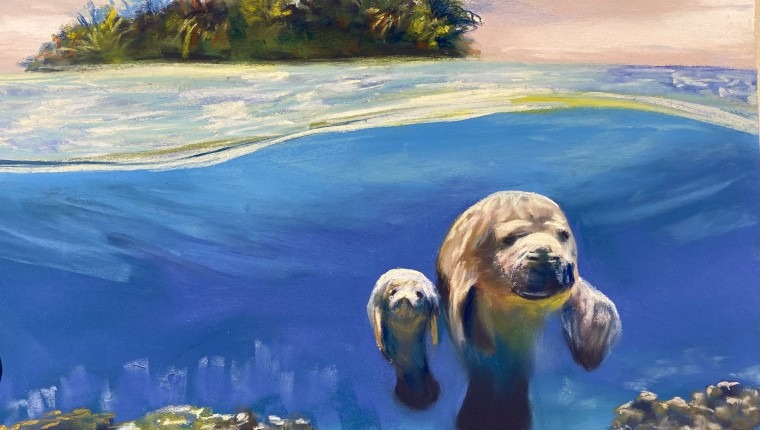Almost every artist I know works from photos at some time or other. Most artists shoot photos that wind up being paintings, and some use photos culled from social media or websites as photo reference on occasion. Many people walk into a class, pick up a supplied photo reference, and make a jaw-dropping painting from it, and then want to show their new favorite painting to the world!
this is a photo I took from the internet:

This is one of the paintings I did based on this photo-
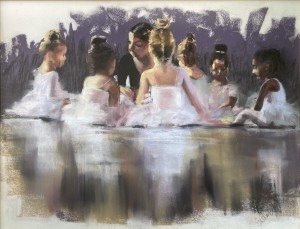
Now this was a demonstration painting, and the photo itself was on Unsplash which is a website that allows you to use images without asking permission or paying royalties.
Not everyone stops to think about the legality. I know I often don’t myself. I catch myself clicking “save” on other people’s photos just because I like the figure, or the sunset, then I realize what I’ve done.
Now imagine how you would feel if you stayed up all night, waist-deep in waders in the everglades, fending off mosquitoes and boa constrictors with an old-fashioned box camera, waiting for the just the right light when the sun rises. Click! You capture it, and triumphantly post it to your social media, only to see twenty paintings of that same scene suddenly populate your feed as well.
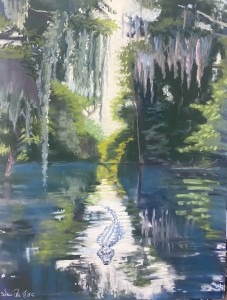
No this is not based on Clive Butcher’s photo but it could’ve been!
This is based on plein air sketches of Brooker Creek and the gator is added from imagination.
Now there is nothing wrong with with this legally unless you are trying to sell the painting you made based on someone else’s photo. You can copy anything; masterpieces in museums, celebrity likenesses, even Clive Butcher’s famous photos, as long as you are doing it for your own use, as protected free speech. However, you cannot exhibit or sell this work at any point without violating the original artist’s intellectual property.
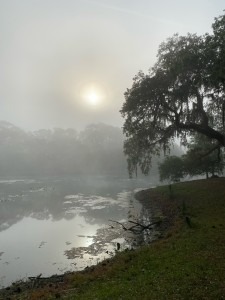
John Chestnut Park in the mist (facebook photo of a friend)
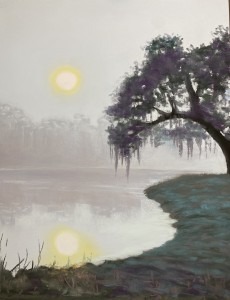 My interpretation of her photo.
My interpretation of her photo.
Here in lies the rub.
What if you made it out of icing on a cake? Would that be considered a violation? Intellectual property can be a tricky thing to define.
Malcolm Gladwell (my favorite author, and current crush) was once plagiarized, and wrote a brilliant article in the New Yorker Magazine about it, and the difference between borrowing that is transformative and borrowing that is derivative.
In his essay, he explains that borrowing that is transformative is where you are inspired by someone else’s idea, but you transform it into your own work of art. For example, making a series of cupcakes decorated as Alice in Wonderland characters. If Lewis Carroll, were alive to be offended by your action, he would not have a legal leg to stand on because you are merely interpreting the storybook characters in confectionary. Vastly different then if you wrote a sequel to his book where Alice’s brother comes down the rabbit hole looking for her, which would be “borrowing that is derivative.”
In the second example, the work of art would not stand on it’s own merits-the story of Alice’s brother would not make any sense without the original story. For something to be derivative, it needs to be based mainly on the original artwork, if you take that away, it doesn’t hold its own.
This is an excerpt from Gladwell’s New Yorker essay where he uses Beethoven’s 5th as an example:
Ferrara then played the most famous four-note sequence in classical music, the opening of Beethoven’s Fifth: G, G, G, E-flat. This was unmistakably Beethoven. But was it original? “That’s a harder case,” Ferrara said. “Actually, though, other composers wrote that. Beethoven himself wrote that in a piano sonata, and you can find figures like that in composers who predate Beethoven. It’s one thing if you’re talking about da-da-da dummm, da-da-da dummm—those notes, with those durations. But just the four pitches, G, G, G, E-flat? Nobody owns those.”
(and NO I didn’t ask his permission to reprint it here, I just did it, and gave him credit for it!)
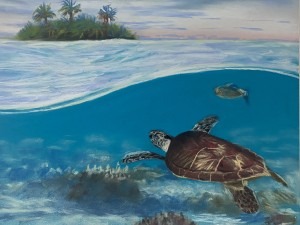 This is my version of the Unsplash photo pastel painting called “Journey” (since lost the photo and couldn’t find it on Unsplash)
This is my version of the Unsplash photo pastel painting called “Journey” (since lost the photo and couldn’t find it on Unsplash)
A situation came up recently where one of my online class artists decided to put a painting she did in class, in a group show. She asked me about the photo reference, and whether she could sell the painting or not.
When I teach classes, I try to use my own photos but will occasionally buy or use photos from sites like Unsplash, or IStock photo, etc. Especially if I am looking for a specific place, or animal (for example a Hawksbill Sea turtle).
Buying rights gives you limited permission to use the photo for your own purposes such as advertising copy, or other uses stipulated in the agreement. Many websites geared toward artists fully expect that you will paint from the photos, and ask artists to post their finished works as well. This is the case for a facebook group I belong to called “Landscape Artists Reference Photos” which I have taken a few photos from.
I researched the photo I used for the class and it was licensed through Unsplash which is a free service. There’s no specific contract for the use of this photo, so technically, she could show and sell her painting without facing recrimination.
That brings up the moral question.
Is it right to make a painting based on someone else’s photo and sell it? A photo is a completed work of art. It is the composition created by the photographer in the camera’s lens. When we copy a photo exactly, without interpreting it, or changing it, we are technically plagiarizing someone else’s work even with their permission.
The important concept here for artists is the “transformative” part. When we borrow someone else’s idea and transform it into our own work then we have substantially changed the concept.
I often paint from cultural references like magazine ads, newspaper photos, even old master’s works. I don’t always give credit because sometimes, the only thing I am borrowing is the idea; how the figure is silhouetted in the fountain, or auras around the stars like Van Gogh’s “Starry Night.” No one would look at my painting and immediately think it was related to the original idea. It’s borrowing that is transformative.
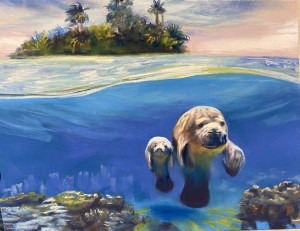
“Prayer for the Manatees” was a painting I did based on the turtle photo but is more transformative.
Now there’s rules about this sort of thing in the art world. Specifically, in the pastel world. It is highly frowned upon to use other people’s photos. In fact, if you wish to post your painting on the Pastel Society of America facebook page, you must state that it was done from your own photo, or from life. You are not allowed to post anything that is painted from someone else’s photo, even if you have their permission, or have purchased rights to use the photo in a painting.
The same is true for most juried art competitions. In the prospectus, it will ask specifically if the painting was made during a class, or from someone else’s photo.
This can be debilitating for a disabled or house-bound artist who paints wildlife for example. Or a pet portrait artist who is forced to work from pet owner’s favorite photos, and can never show her work in competitive shows because of this glitch.
On the other hand, if you are an artist who has created a fabulous painting of bears juggling and want to make sure no one else ever copies your work, you may have a challenge on your hands. No one can copyright an idea like “juggling bears” but you can copyright your own painting of three bears laughing and juggling.
If you happen to see your juggling bears painting appear in your newsfeed on the latest whiz-bang from China, you can attempt to sue, but only if you registered that painting with the copyright office. Otherwise, it is very difficult to prove that the Chinese manufacturer didn’t come up with the same idea, at the same time. These things happen.
Finally, there’s a big difference between trademark and copyright. You can copyright a whole body of work; “Surf boards on top of vans” series of acrylic paintings, but you cannot copyright someone else’s trademark into one of your paintings. IE: Surfboards on top of Volkswagen Vans.
You can’t paint someone’s trademark in your painting without infringing upon their trademark. For example Volkswagen sued an artist to remove the shape and logo of their trademark from a painting the artist did of bebops (otherwise known as Bugs, or the rounded commuter car made by Volkswagen). This trademark infringement held up in court and the artist was sued by the big corporation. So much for fahrvergnugen!
Epilogue, my online artist colleague decided to show a different painting in the group show so that she could offer it for sale. I think she made a principled decision, and hope it inspires us all to do the right thing.
Disclaimer: Please realize that I am not a lawyer, only an outspoken artist that occasionally steals images from the public domain to make paintings. Check with a copyright attorney if you want to be absolutely sure!
